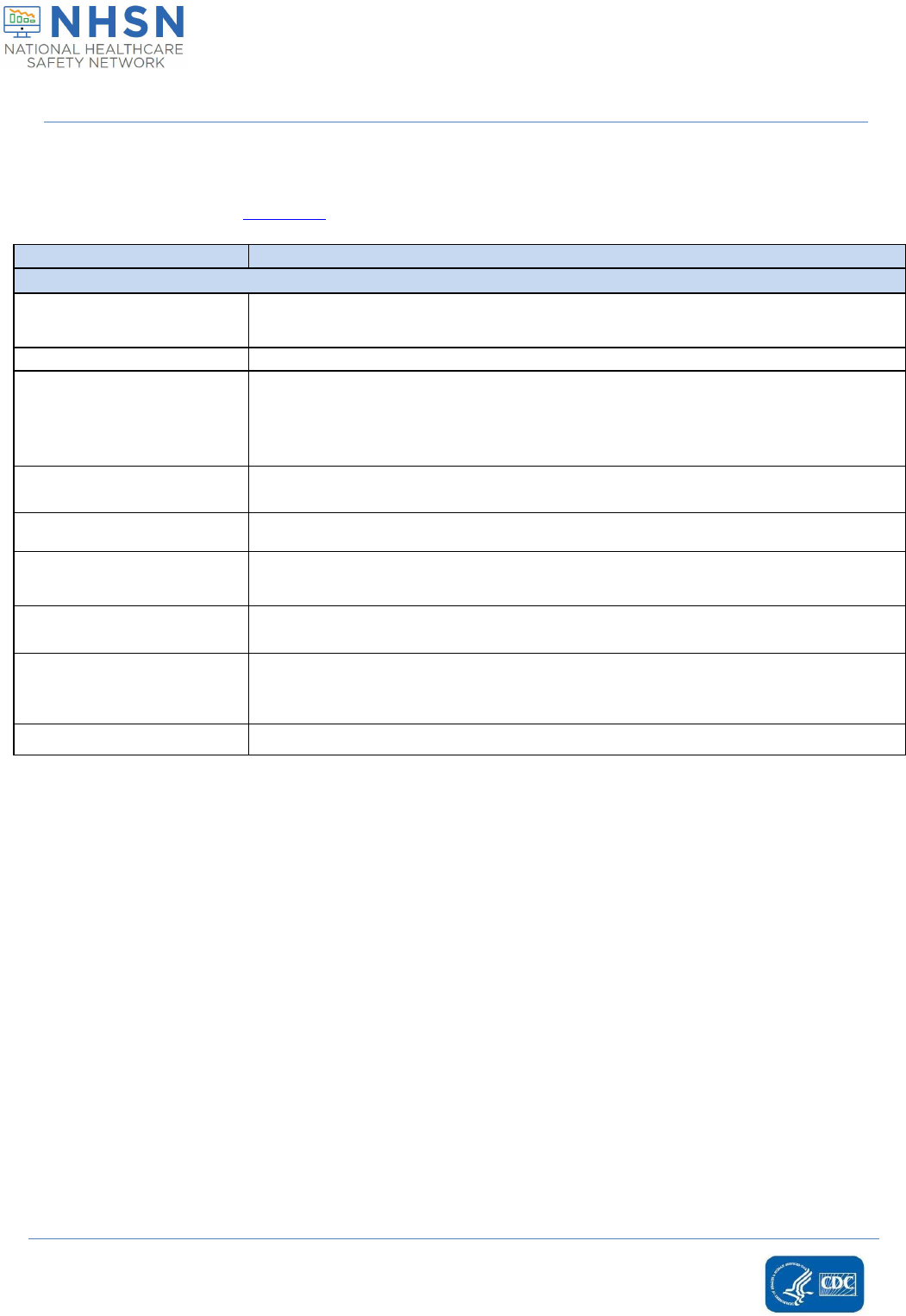
June 2024
Page 1
Table 4. Instructions for Completion of the Urinary Tract Infection for
LTCF form (CDC 57.140)
Data Field
Instructions for Form Completion
Resident information
Facility ID
Required. The NHSN-assigned facility ID number will be auto populated by the
system.
Event ID
Event ID number will be auto populated by the system.
Resident ID
Required. Enter the alphanumeric resident ID. This is the resident identifier
assigned by the facility and may consist of any combination of numbers and/or
letters. This should be an ID that remains the same for the resident across all
admissions and stays.
Medicare number
Optional. Enter the resident Medicare number or comparable railroad insurance
number.
Resident Name
Optional. Enter the name of the resident (last, first, middle).
Gender
Required. Select M (Male), F (Female) or Other to indicate the gender of the
resident.
Sex at Birth
(Birth Sex)
Optional. Select Female, Male, or Unknown, to indicate the sex assigned at birth of
the individual.
Gender Identity
Optional. Select Male, Female, Female-to-male transgender, Male-to-female
transgender, identifies as non-conforming
, Other, or Asked but unknown, to indicate
the gender identify which most closely matches how the resident self-identifies.
Date of Birth
Required. Select the date of the resident’s birth using the drop-down calendar.

June 2024
Page 2
NHSN Long-term Care Facility Component
UTI Event Form Instructions CDC 57.140
Data Field
Instructions for Form Completion
Ethnicity (specify)
Required. Enter the resident’s ethnicity:
Hispanic or Latino; Not Hispanic or Not Latino; Declined to Respond; Unknown.
Hispanic or Latino is defined as a person of Cuban, Mexican, Puerto Rican,
South or Central American, or other Spanish culture or origin regardless of
race.*
The resident should always be asked to identify their race and ethnicity. If
the resident is not a good historian, then check with a reliable family
member.
NOTE: Collecting race and ethnicity is important for understanding
trends and ensuring the wellbeing of racial and ethnic minority groups. However, if
after all attempts it is not possible to obtain ethnicity information, the appropriate
response below, may be chosen:
• Declined to respond
• Unknown
* https://www.census.gov/topics/population/hispanic-origin/about.html
Race (specify)
Required. Specify one or more of the choices below to identify the individual’s
race.
NOTE: Collecting race and ethnicity is important for understanding trends and
ensuring the wellbeing of racial and ethnic minority groups.
• American Indian/Alaska Native
• Asian
• Black or African American
• Native Hawaiian/Other Pacific Islander
• White
• Declined to respond
• Unknown
This data should be based upon the individual respondent’s self-identification with
regards to race. If the resident is a poor historian, solicit information from a reliable
family member.
NOTE: Hispanic or Latino is not a race, a person may be of any race while being
Hispanic or Latino.
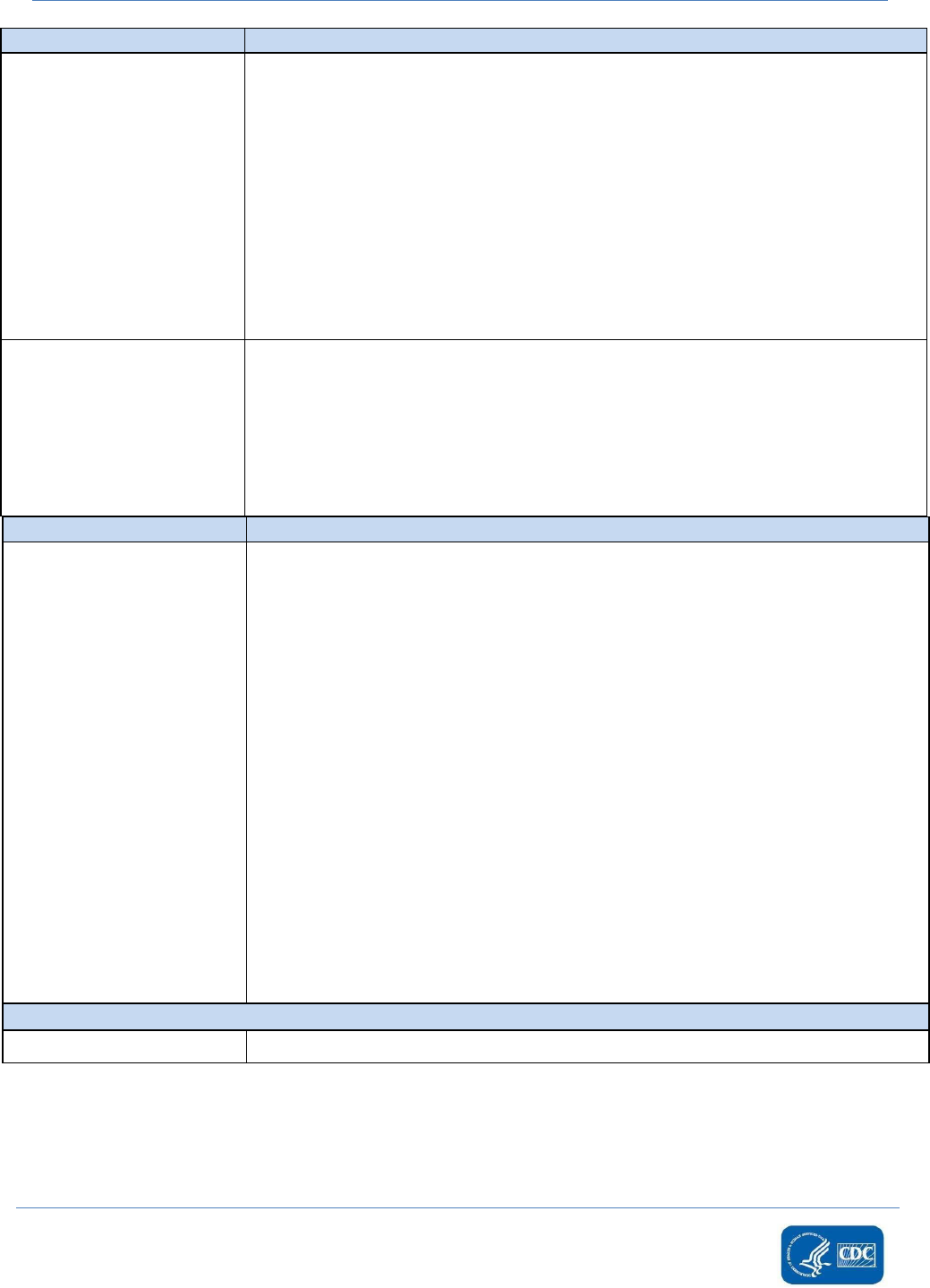
June 2024
Page 3
NHSN Long-term Care Facility Component
UTI Event Form Instructions CDC 57.140
Data Field
Instructions for Form Completion
Date of Current Admission to
Facility
Required. The date of current admission is the most recent date the resident
entered the facility. If the resident enters the facility for the first time and has not
left, then the date of current admission will be the same as the data of first
admission. Select the date of current admission using the drop-down calendar.
Notes:
• If the resident leaves the facility for more than 2 calendar days (the day the
resident leaves the facility is equal to day 1) and returns, the date of current
admission should be updated to the date of return to the facility.
• If the resident has not left the facility for more than 2 calendar days, then the
date of current admission should not change.
• Date of current admission must occur BEFORE the date of event.
Example: A resident is transferred from your facility to an acute care facility on
June 2, 2023, and returns on June 5, 2023, the current admission date would be
06/05/2023. One week later, the same resident goes to the ED for evaluation on
June 12, 2023, and returns on June 13, 2023. The date of current admission stays
06/05/2023.
Event Information
Event Type
Required. Event type = UTI
Data Field
Instructions for Form Completion
Resident Type
Non-editable. Auto-populated by NHSN system as short stay or long-stay based on
the date of first admission to the facility and the event date. Specifically, the
definitions are:
□
Short stay: Resident has been in facility for 100 or less days from date of
first admission. In other words, if the Event Date minus the First Admission
Date is less than or equal to 100; then resident type should be “SS”
□
Long stay: Resident has been in facility for more than 100 days from date of
first admission. In other words, if the Event Date minus the First Admission
Date is greater than 100 then the resident type should be “LS”
Important: Users are NOT permitted to edit the auto-populated resident type.
Date of First Admission to
Facility
Required. The date of first admission is defined as the date the resident first
entered the facility. This date remains the same even if the resident leaves the
facility (for example, transfers to another facility) for short periods of time (less
than 30 consecutive days). If the resident leaves the facility and is away for 30 or
more consecutive days, the date of first admission should be updated to the date of
return to the facility. Select the Date of First Admission using the drop-down
calendar.
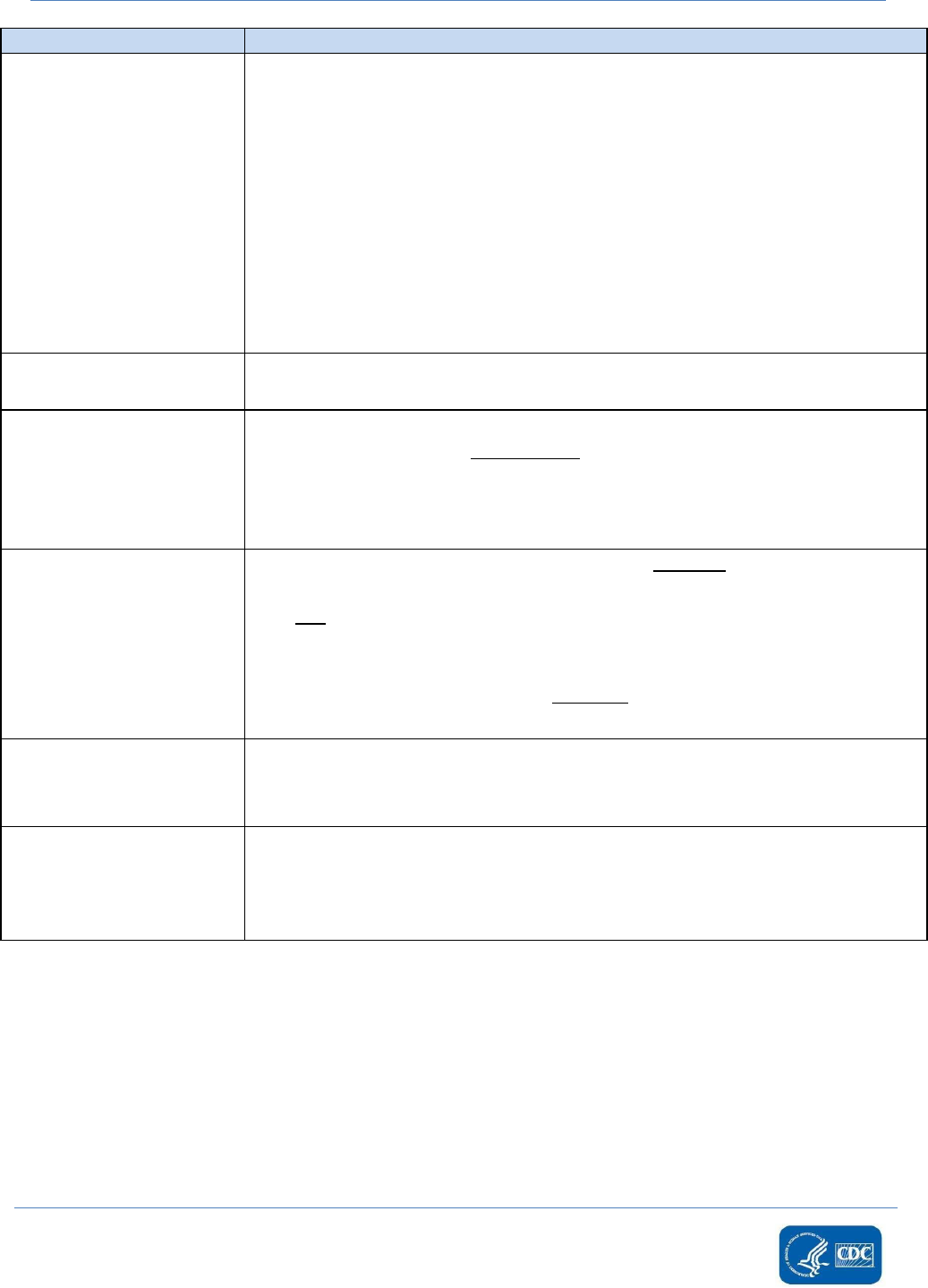
June 2024
Page 4
NHSN Long-term Care Facility Component
UTI Event Form Instructions CDC 57.140
Data Field
Instructions for Form Completion
Date of Event
Required: Enter the date when the first clinical evidence (signs or symptoms) of
infection were documented or the date the specimen used to meet the infection
criteria was collected, whichever comes first. Note: Date of event must occur AFTER
the current admission date. Select the date of event using the drop-down calendar.
Example: A resident had an indwelling urinary catheter (also called a Foley
catheter) in place and had documentation of new suprapubic pain on June 1st. The
resident had a urine specimen collected and sent for culture June 3rd. The Date of
Event would be June 1st since this is the date of symptom onset and occurred
before the date of culture collection.
Resident Care Location
Required. Enter the location where the resident was residing on the Date of Event.
Primary Resident Service
Type
Required. Check the single primary service that best represents the type of care the
resident is receiving on the Date of Event:
Long-term general nursing, long-term dementia, long-term psychiatric, skilled
nursing/short-term rehab (subacute), ventilator, bariatric, or hospice/palliative.
Has resident been
transferred from an acute
care facility in the past 4
weeks?
Required. Select “YES” if the resident has been an inpatient of an acute care facility
(hospital, Long-term acute care hospital, or acute inpatient rehabilitation facility
only) and was directly admitted to your facility in the past four weeks (specifically
28 days, with the day of specimen collection being day 1) prior to the current event
date. Otherwise, select “NO.” Note: A transfer from an outpatient setting, such as
an emergency department or clinic is excluded since these settings visits do not
represent an inpatient admission.
If yes, date of last transfer
from acute care to your
facility?
Conditionally required: If the resident was transferred from acute care to your
facility in the past 4-weeks, select the most recent date of transfer using the drop-
down calendar.
If yes, did resident have an
indwelling urinary catheter
at the time of transfer to
your facility?
Conditionally required: Select “YES” if the resident was transferred from acute
care to your facility with an indwelling urinary catheter (also called a Foley
catheter); otherwise, select “NO.”
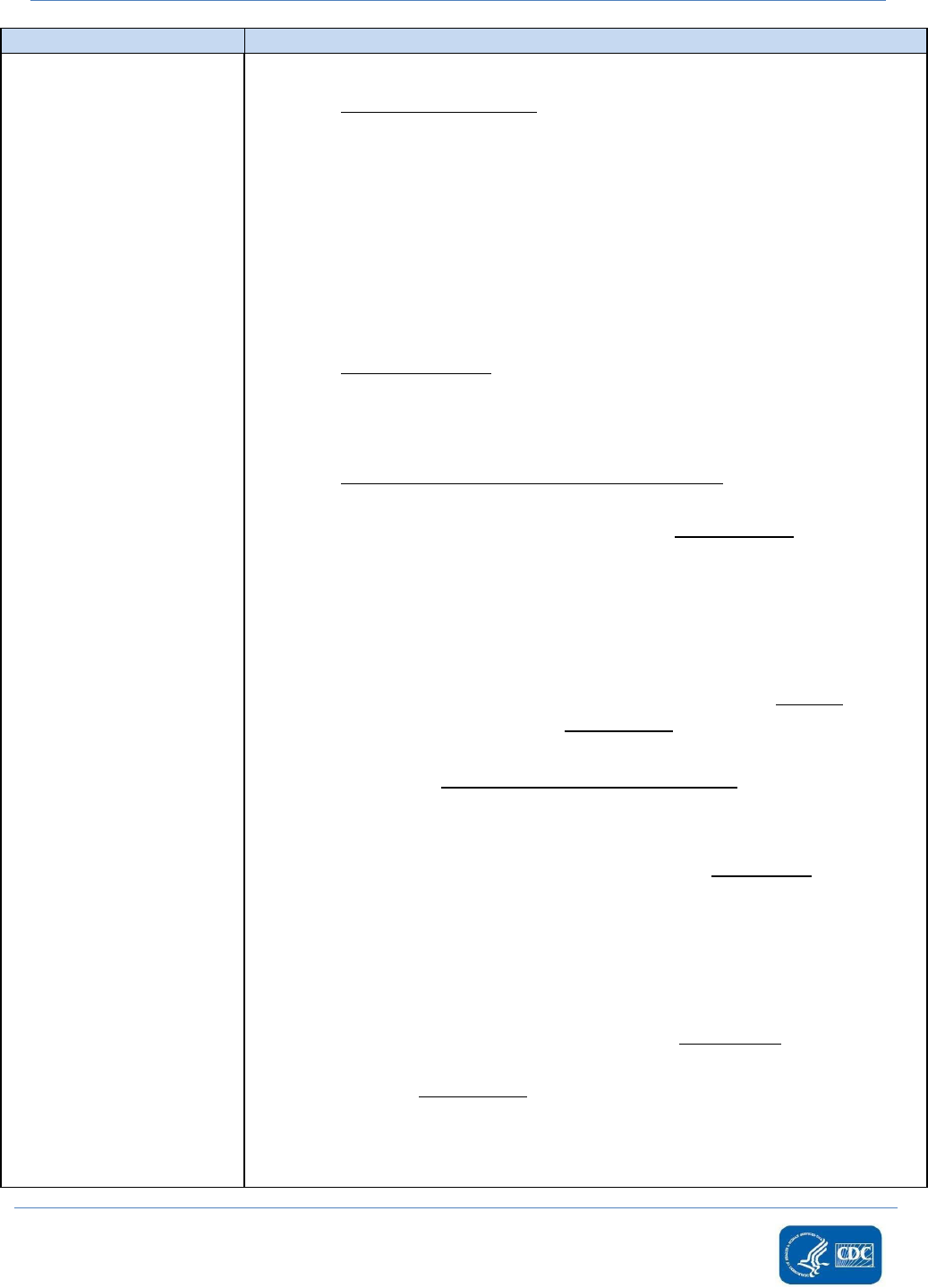
June 2024
Page 5
NHSN Long-term Care Facility Component
UTI Event Form Instructions CDC 57.140
Data Field
Instructions for Form Completion
Indwelling urinary catheter
status at time of event onset
Required. Select one of the three options below:
□
Check: NEITHER -Not in place if:
Resident has/had an indwelling urinary catheter, but it has/had not been in
place for more than 2 consecutive days on the date of event
OR
Resident did not have an indwelling
urinary catheter in place on the date of
event or the calendar day before the date of event
Note: Check “Not in Place” even if a non-indwelling urinary device
is/was in place (for example, suprapubic catheter, external collection
devices)
□
Check: INPLACE (In place) only if an indwelling urinary catheter (also called a
Foley catheter) had been in place in for more than 2 consecutive calendar days
and was present for any portion of the calendar day of the date of event. Note:
This question is not referring to how the specimen was collected.
□
Check: REMOVE - Removed within last 2 calendar days if an indwelling urinary
catheter that had been in place in for more than 2 consecutive calendar days
was removed within the 2 calendar days prior to Date of Event (where date of
catheter removal = day 1).
Examples:
A resident had an indwelling urinary (Foley) catheter in place for the past
four days and had documentation of new suprapubic pain on June 1. The
resident had a urine specimen collected and sent for culture June 3rd. The
culture was positive for E. coli at 100,000 CFU/ml. Check In place as the
urinary catheter status on the Date of Event.
If the indwelling catheter from the above example had been removed on
May 31, check Removed within last 2 calendar days since the May 31, the
date of removal, is day 1 and June 1 (Date of Event) is day 2.
If the indwelling catheter from the above example was removed on May
30 (May 30 = day 1, May 31 = day 2), then check Not in place since the
catheter was removed > 2 calendar days prior to June 1 (Date of Event).
A resident had an indwelling urinary (Foley) catheter placed on June 1. On
June 2 she complained of new suprapubic tenderness and had new onset
of hypotension without another non-infectious cause. The resident had a
urine specimen collected and sent for culture June 3rd. The culture was
positive for E. coli at 100,000 CFU/ml. Check Not in Place since the urinary
catheter had not been in place for more than two consecutive calendar
days on the Date of Event. Calendar day 1 of placement = June 1;
Calendar day 2 = June 2, which was also the day of symptom onset (date
of event). So, the indwelling catheter had only been in place two calendar
days on the Date of Event.
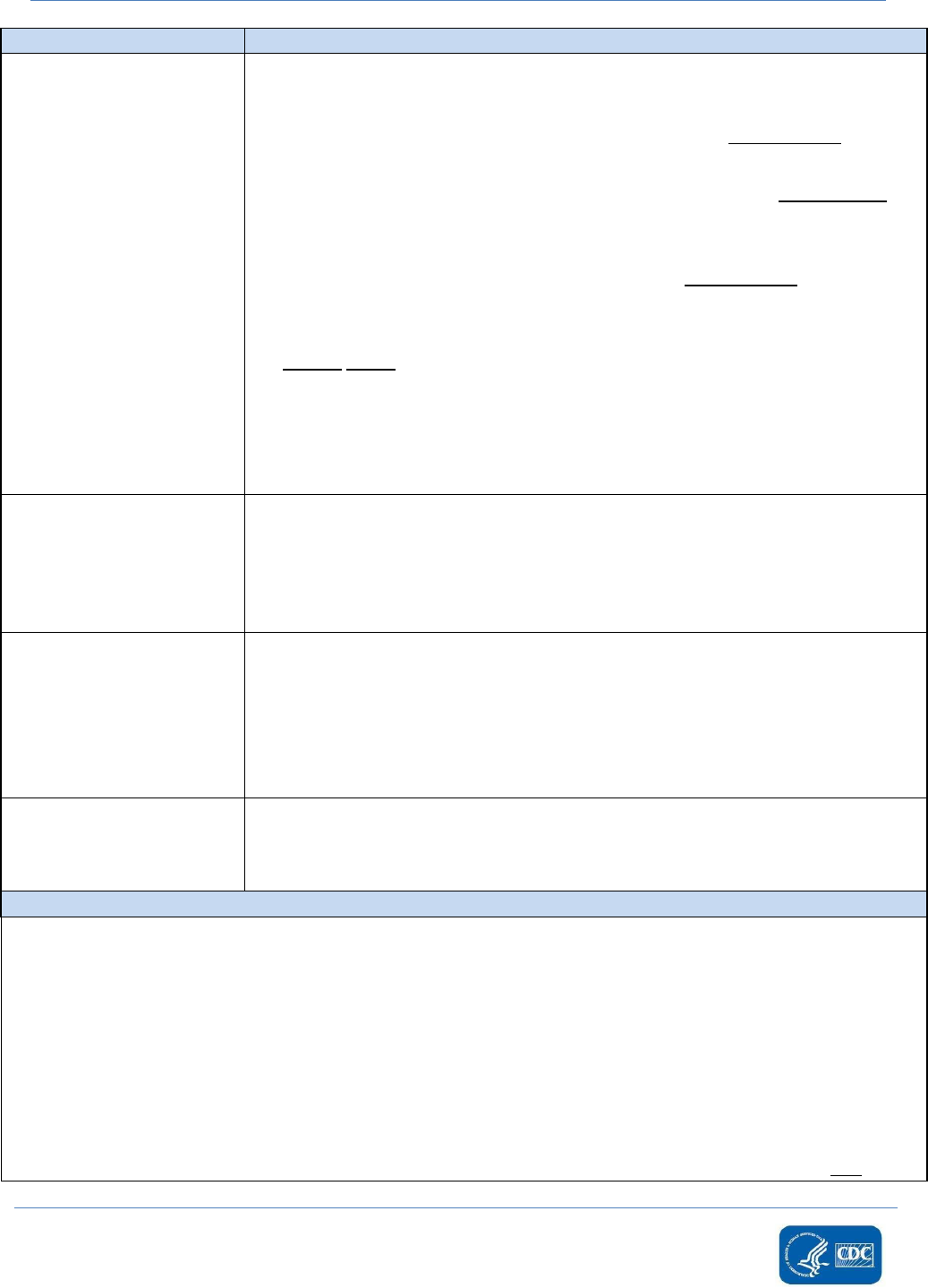
June 2024
Page 6
NHSN Long-term Care Facility Component
UTI Event Form Instructions CDC 57.140
Data Field
Instructions for Form Completion
If indwelling urinary catheter
status In place or Removed
within last 2 calendar days:
Site where device i
nserted
(check one)
Conditionally Required. If an indwelling urinary catheter was in place or removed
within last 2 calendar days, select one of the four options below:
□
Check “FAC-Your facility” if the catheter present on the Date of Event was
placed or changed in your LTCF;
□
Check “AC-Acute care hospital” if the catheter present on the Date of Event
was placed in an acute care facility (Hospital, Long-term acute care hospital, or
acute inpatient rehabilitation facility only) and not changed in your facility;
□
Check “OTH-Other” if the catheter present on the Date of Event was placed in
another non-acute care facility and not changed in your facility;
□
Check “UNK-Unknown” if it is not known where the catheter present on the
Date of Event was inserted.
Note: Site of device insertion corresponds to the site of insertion or replacement
of the indwelling urinary catheter in place at the time of the UTI event.
Date of indwelling urinary
catheter insertion
Optional. If available, use the calendar drop down menu to select the date the
device was placed using this format. Note: if the resident was transferred into the
facility with an indwelling urinary catheter in place, and the LTCF replaces the
catheter with a new one, then the date of device insertion should represent the
date the new catheter was inserted.
If indwelling urinary catheter
was not in place, was
another urinary device type
present at the time of event
onset?
Conditionally required. Select “YES” if another urinary management device was
used. Specifically, a SUPRA-Suprapubic catheter, external drainage device for males
or females (for example, condom catheter), or INTER- Intermittent Straight
Catheter (in and out catheter).
Otherwise, select “NO.”
If “YES,” select other device
type
Conditionally required. If a device other than an indwelling urinary catheter was
being used, specifically a SUPRA-Suprapubic, External Drainage, or INTER-
Intermittent Straight, select the option from the drop-down menu.
Specific Criteria Used: Check all that apply
Important: Before submitting a UTI event to NHSN, verify that NHSN specific UTI criteria are met. Only UTIs
meeting NHSN criteria will be accepted in the application. For example, the selected UTI event criteria must meet
the NHSN criteria for:
□
SUTI-symptomatic UTI when indwelling urinary catheter status at the time of even onset was answered as
“NEITHER-Not in place”.
□
CA-SUTI-Catheter-associated symptomatic UTI when indwelling urinary catheter status at the time of
even onset was answered as “REMOVE- Removed within last 2 calendar days” or “INPLACE-In place”.
□
ABUTI-Asymptomatic bacteremia if the resident did not have signs or symptoms of a UTI, but did have a
positive urine culture with at least one matching positive blood culture or a fever was selected and
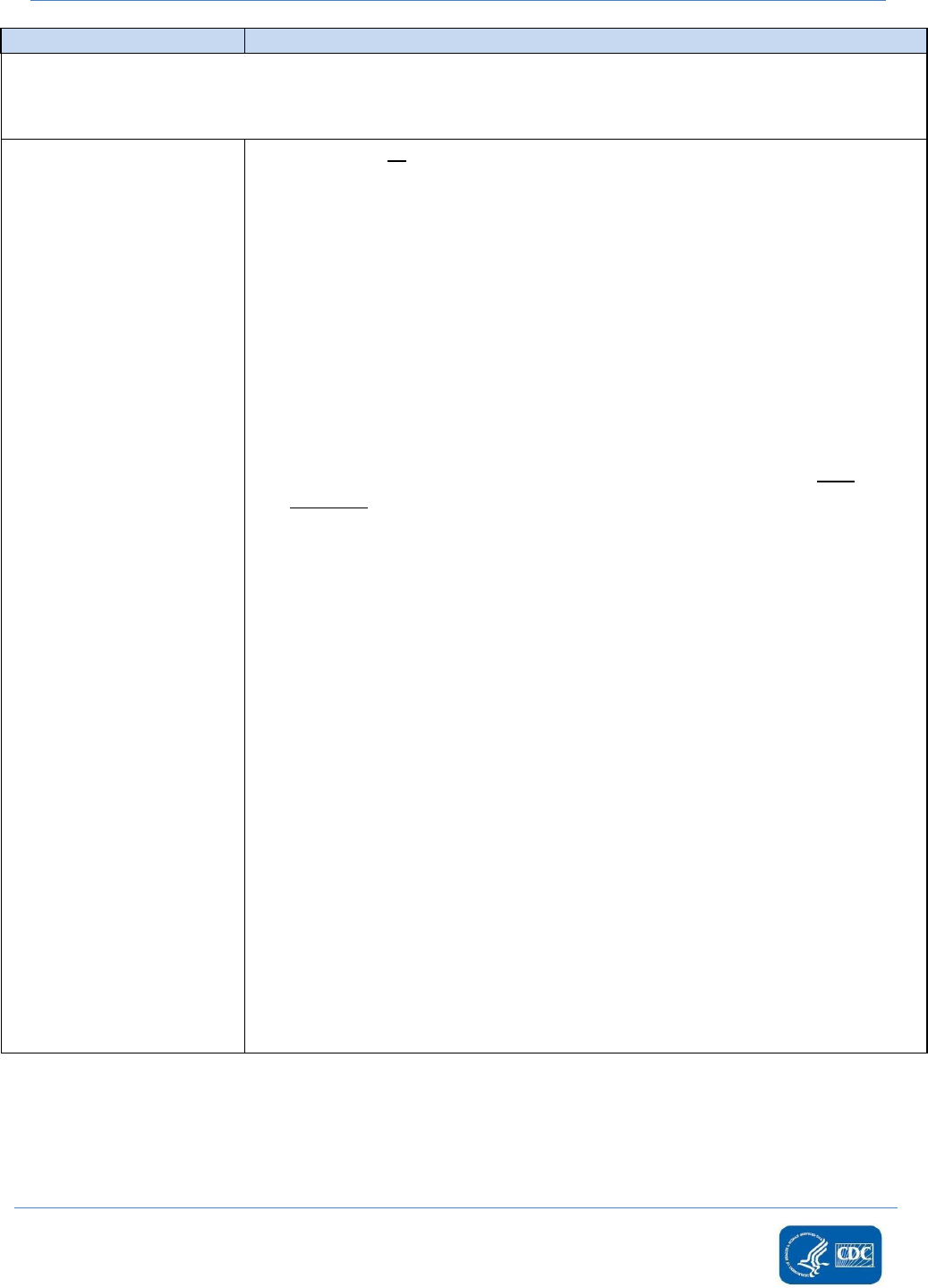
June 2024
Page 7
NHSN Long-term Care Facility Component
UTI Event Form Instructions CDC 57.140
Data Field
Instructions for Form Completion
indwelling urinary catheter status at the time of event onset was answered as “NEITHER-Not in place”
(note- a fever is not considered a symptom in a resident without an indwelling urinary device in place at
the time of event onset)
Signs and Symptoms
Required. Check all the clinical criteria identified and documented in the resident
record that were used to identify the UTI being reported. Please refer to the flow
diagram in the protocol to determine which criteria are needed to qualify as a
specific event type.
Fever: Single temperature above 100°F or repeated temperature readings
(more than one reading) above 99°F or an increase of more than 2°F over the
residents’ baseline temperature (temperature when resident is well). Note:
Since fever is a non-specific symptom, if present, fever must be used to meet
UTI criteria even if resident has another infection, such as pneumonia, that may
be the cause of the fever.
Rigors (a sudden feeling of cold with shivering accompanied by a rise in
temperature).
New onset of hypotension (low blood pressure) with no alternate non-
infectious
cause (for example, medication known to cause low blood pressure).
Note: since hypotension is a non-specific symptom, it should be used to meet
CA-SUTI criteria even if resident has another source of infection, such as
pneumonia, that could be the cause of the hypotension.
New onset of confusion or functional decline with no alternate diagnosis. Note
:
resident must also have leukocytosis to meet this criteria for CA-SUTI.
Acute pain, swelling, or tenderness of the testes, epididymis, or prostate.
Acute dysuria (painful urination).
Purulent (milky, pus-like) drainage/discharge from around the catheter
insertion site.
New or marked increase in urinary urgency.
New or marked increase in urinary frequency.
New or marked increase in incontinence.
New or marked increase in acute costovertebral (CV) angle pain or tenderness.
Note: CV angle is one of the two angles that outline a space over the kidneys;
the angle is formed by the lateral and downward curve of the lowest rib and
the vertical column of the spine.
New or marked increase in suprapubic (lower, center part of the abdomen)
tenderness.
New or marked increase in visible (also referred to gross) hematuria (visible
blood in the urine).
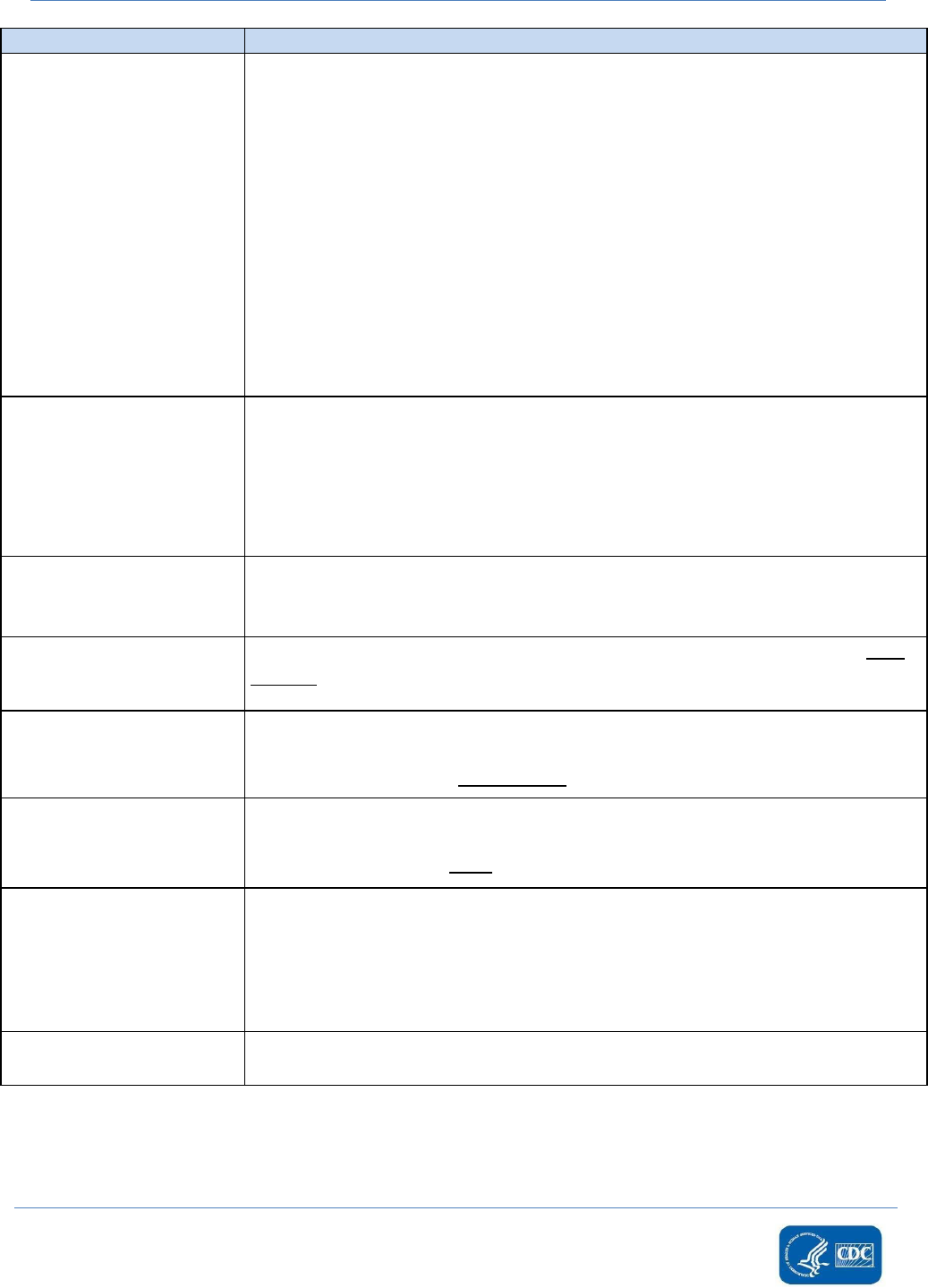
June 2024
Page 8
NHSN Long-term Care Facility Component
UTI Event Form Instructions CDC 57.140
Data Field
Instructions for Form Completion
Laboratory and Diagnostic
Testing
Required. Check all the laboratory and diagnostic testing obtained and
documented in the resident record that were used to confirm the UTI being
reported. Note: A positive urine culture with at least one bacterium of ≥ 10
5
CFU/ml (≥100,000 CFU/ml) is required to meet criteria for UTI.
Positive urine culture with no more than 2 species of microorganisms, at least
one of which is a bacterium of ≥ 10
5
CFU/ml (≥100,000 CFU/ml).
Leukocytosis [defined by NHSN as > 10,000 cells/mm^3, or Left shift (> 6% or
1,500 bands/mm^3)].
A positive blood culture with at least one matching organism to an organism
identified in the urine culture.
Note: The microorganisms must be identified to the genus and species level. If the
culture reports “mixed flora” or “contamination”, this would
NOT
meet criterion.
Specific Event
NHSN will auto-populate the specific UTI Event Type based on the event information
selected. If the Specific Event Type does not auto-populate, please verify that
entered criteria meet one of the NHSN UTI criteria. If NHSN UTI criteria are not met,
you must delete the event from NHSN, or your data will be considered as
incomplete. Incomplete data will trigger Alerts on the NHSN homepage and prevent
data from populating in the LTCF dashboard.
Secondary bloodstream
infection?
Optional. Check “YES” if resident has a microorganism reported in a urine culture
and has the same microorganism reported from a blood culture. Otherwise, check
“NO.”
Died within 7 days of event
date?
Optional. Check “YES” if resident died from any cause within 7 days after the Date
of Event, otherwise check “NO.”
Transfer to acute care facility
within 7 days?
Required. Check “YES” if resident was transferred to an acute care facility (hospital,
long-term acute care hospital, or acute inpatient rehabilitation facility only) for any
reason in the 7 days after Date of Event, otherwise check “NO.”
Pathogens identified
Required. Enter “YES” and specify organism name(s) and sensitivities listed on the
paper form. For SUTI with secondary BSI and ABUTI, enter only the matching
organism(s) identified in both urine and blood cultures.
Custom fields and labels
Optional. Up to 50 fields may be customized for local or group use in any
combination of the following formats: date (MMDDYYYY), numeric or alphanumeric.
Note: Each Custom Field must be set up in the Facility/Custom Options section of
NHSN before the field can be selected for use.
Comments
Optional. Enter any information on the event. Entered information is for facility
internal use only and is not analyzed by NHSN.
